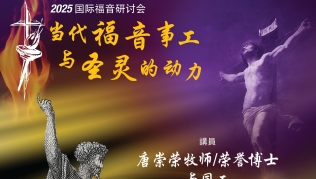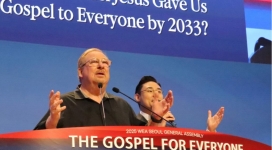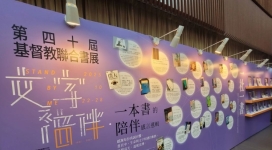The Christian Post conducted an exclusive interview with Dr. Rev. Samuel Ling, an active historian, lecturer, theologian and ordained minister of the Presbyterian Church America for the special feature entitled, ‘An Overview of the Chinese-American Churches in the 21st Century’. Dr. Ling has provided an enriched, well-ordered documentation of the Chinese American Churches during the course of the following interview.
1. Dr. Samuel Ling, can you please give a brief introduction on the general historical background of Chinese American Churches?
First Chinese American churches were organized by mainline denominations before and during the 1840. The example would be the Cameron House Christian house church of San Francisco. By 1950s the National Council of Churches in the USA did a survey and reported less than several dozens of Chinese churches. However today, there are more than 1000 churches in the US and Canada combined.
2. Please comment on the current direction of the Chinese Churches in the US. Are they progressing from their traditional heritage?
Actually from 1880s through 1930s according to Dr. Timothy Tseng--he's at the American Baptist Seminary of the West in Berkeley, CA--Chinese Christians in America contributed very meaningfully to the nationalist cause, particularly the revolution of 1911. In a sense this was very progressive. They were happy to see Sun Yat-sen lead the revolution to overthrow the Manchu dynasty which succeeded in 1911. However the china town community, largely thanks to the Exclusion Act of 1882 passed by the US Congress, was drawn to the Chinese churches. The Chinese churches and clan associations were the two primary sources of social services for the community such as assisting illiterate men with a way to write letters home. The churches were what they turned to - along with clan associates. Both were important sources of community service.
The Chinese church has often resisted assimilation into American society. Yet this resistance is the very embodiment of the assimilation itself, in seeking to preserve the Chinese culture. The Chinese culture has indeed become American in a way. Through this process they have lost great bit of American born Chinese, and the immigrant leadership themselves have Americanized very significantly often without admitting that.
Dr. Ling, please elaborate further on the character of the Chinese American Christian community. To help you answer that question, would you say that the community is following the same pattern as some other ethnically grouped Christian communities in the US such as the Korean-American Christians?
Same patterns? Chinese churches have been around long before Koreans came. Before the 1970s the primary denomination that started the Chinese churches were Presbyterians, Congregationalists, Methodists and various southern Baptists. The Episcopal church contributed as well. The situation has changed around in 1970s and today the largest group of Chinese protestant groups is independent. Followed by Baptists of all sorts and general Baptists and evangelical covenant, which is really just another Baptist. Also conservative Baptists and evangelical Baptists. Followed by the largest Chinese Christian group - the Christian missionary alliance. By far these are the largest groupings. Then you drop down to the low down force; I would say that the Presbyterians and Methodists might pick up at that point. Mennonite in Canada is rather strong but by far the largest groups of Chinese churches are independent, non-denominational.
3. Please comment on the transformation of the Chinese American Churches over the last five decades, emphasizing the church growth. Have they flourished over the years or have fallen in development?
In terms of the numbers of the congregations, the Chinese churches have mushroomed in the 1970s. In terms of the persons per congregation, there has been somewhat of increase. I do not know the exact number my guess is that the average of American Chinese church is 150 people in attendance, up from early 90s. The number per congregation has climbed from the 80s to 120 in 90s. Most Chinese churches have English worship services as well as children’s program. While we are losing number of university graduates, the sheer immigrant influx keeps the number filled. In the 1970s the young American adult had to put up a "fight" in order to advocate for an English service. They have failed but times have changed. Today, every other Chinese church is seeking an English pastor. One reason for that change is the leadership - elders and ministers and deacons, they are raising families such that their children are now reaching universities. The English ministries and grace in our lives support us through an imperfect life’s journey, which has become evident by the 1990s. So I would say that the resistance has dropped in the 80s and by 90s hiring the pastors for the English services have become the norm. They may be immigrant or non-Chinese. Immigrant, American born Chinese; mainly Caucasian or Korean-English congregation pastors. The Caucasian English speaking pastor can be recent seminary graduate or seasoned missionary who has returned from service in Asia.
4. What do you believe are some of the crucial theological issues concerning the Chinese American Christians of the 21st century?
I believe the evangelical community is losing its historic evangelical foundations. In seeking church growth and in reaching out to the contemporary "post-modern" society, some of the larger Chinese churches are often quite eager to repackage the gospel in such a way to de-emphasize the historic doctrinal formulation of scripture and salvation.
Theological issues that are current in the broader communities are impacting the Chinese churches. For example, the women's role in church charismatic gifts, and socio-political involvement to name three. Family oriented issues are impacting the pastoral leadership, significantly. Such as divorce, homosexuality and sexual issues in general.
There has always been a need to address our cultural identity as Chinese in North America. That need has only become more acute as the Asian American community is forging its identity often independent of the Chinese church. One practical fall out is - that the Chinese church that seeks an English speaking pastor now faces competition from the Asian church.
Another theological issue is to formulate one strategy toward a Christian presence in China. Some chins churches have opted to assist the registered churches and their seminaries in china. Many in the US particularly much less in Canada, have opted to the unregistered churches in china. Still others are serving china through professional services such as medical, English teaching and business involvement. In general the power and the future of china is a tremendous issue, which has really reshaped the Chinese Christian mind, particularly the immigrant Christian mind. He is now much more ready to engage china in positive way. Whereas in 1970s, china was still a closed country. There was lack of information. Today, many Chinese Christians travel to and China frequently for work or supporting various Christian communities there. i haven't given much through but those are some.
In another angle is immigrant Chinese churches; some leaders in the immigrant Chinese churches see a natural link between elements of Confucian thought and the Christian faith - this comes down to us from the late 1890s when the British American missionaries in china tried to find bridges to reach chinse intellectuals.
Today one Chinese Christian would say that there is a parallel between Taoism and the bible reflecting how strong the tradition Chinese culture as a hold on Chinese Christian minds complete with ethnocentric implications. I am eager to see Chinese churches rethink their identities as global citizens. I see some very encouraging signs in that direction.
Can you discuss the Chinese-American churches’ viewpoint on eschatology?
Scriptural eschatology--the majority of Chinese churches hold onto pre-tribulational and pre-millennialist view however this has dropped from overwhelming to bare majority. Good number of Chinese willing to be pre-millennialist without being pre-tribulation in other without being dispensationalist. Dispensationalism has been the overwhelming view of the older immigrant generation. This is related to the revivals in China in the 1930s and the 1940s.
5. How would you evaluate the current influence of Chinese-American churches in the general U.S. Christian media?
Chinese Americans taking both immigrant and American one together--have been largely aloof to media and politics. There have been exceptions, before 1940, when they were very supportive of the revolutionary and nationalistic cause. June 4, 1989 the Tiannenman Square incident was an exception. Leading Chinese pastors--prominent ones --literally lead processions in the streets; which is an anomaly of general norm of Christians in public events. I understand that this is changing particularly in the North American born and North American raised generations. I see a good bit of interest in the public affairs among Chinese Americans. I can't judge on the influence of media but interest in the public affairs and issues has increased greatly in the last ten years.
6. With which of the following groups would the Chinese churches and members identify themselves? Evangelical, ecumenical or independent?
By far the majority of the Chinese churches would consider themselves evangelical. However by that designation, I would include independent, fundamentalist, and the evangelical congregation in mainline denominations. I see three groups, independent, fundamentalist and evangelical as one conglomerate. There are historic ecumenically oriented congregations. They are not the majority by far, but they continue their ecumenical witness today. They have been consistent in their stance but their numbers don’t show up very well. I think that there has also been ecumenically oriented study programs and so on.
Can you give a brief rationale for such evangelical majority?
In order to understand the Chinese churches in the US and Canada, we must understand the history of:
A. Religious revivals of the 18th and the 19th centuries;
B. The specific segment of missionary movement in china as oppose to Korean;
C. The fundamentalist and revivalist leadership of the church in China in 1930s and 1940s.
All three contributed to the spiritual profile of Chinese church today. Fundamentalism has insisted on the authority of the Bible, Holy living, and a general inclination to be separate from the secular culture and society. This is still the majority stance of Chinese in the US and Canada today.
Rev. Samuel Ling is president of China Horizon, a historian, theologian, and an analyst of critical trends affecting the vitality and purity of the Chinese church. His passion is to call the Chinese church to preserve and defend the inspiration, inerrancy, sufficiency and authority of the Bible. He has lectured at International Theological Seminary, Singapore Bible College, The Reformed Institute, Westminster Theological Seminary in California, Covenant Theological Seminary and elsewhere. Rev. Ling is an advocate of American born Chinese ministry, mainland Chinese (PRC) ministry, and Chinese-western cooperation in China ministry. He is a graduate of Westminster Theological Seminary (M.Div., Th.M.) and Temple University (Ph.D. history), and has published over 500 articles and reviews. He wrote The Chinese Way of Doing Things (P&R, 1999) and co-edited Chinese Intellectuals and the Gospel (P&R 1999). He translated the works of Prof. Lit-Sen Chang (1902-1996).




![[Exclusive Interview] Evangelist Stephen Tong exhorts the Chinese church to return to the foundations of reformed faith](https://www.gospelherald.com/media/cache/thumbnail/7/23/72340sp_273w_150h_1x_1y.png)

![[Exclusive] Rev. Dr. Richard Tin-Wo Cheung: walking between “charismatic” and “evangelical”](https://www.gospelherald.com/media/cache/thumbnail/7/23/72338sp_273w_150h_1x_1y.jpg)
